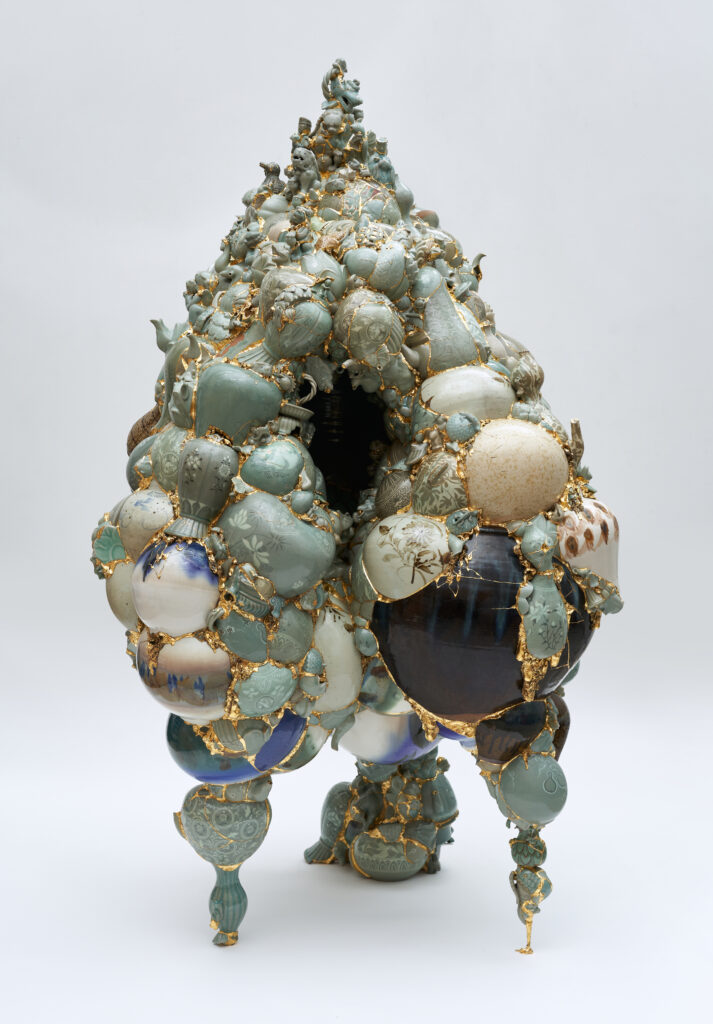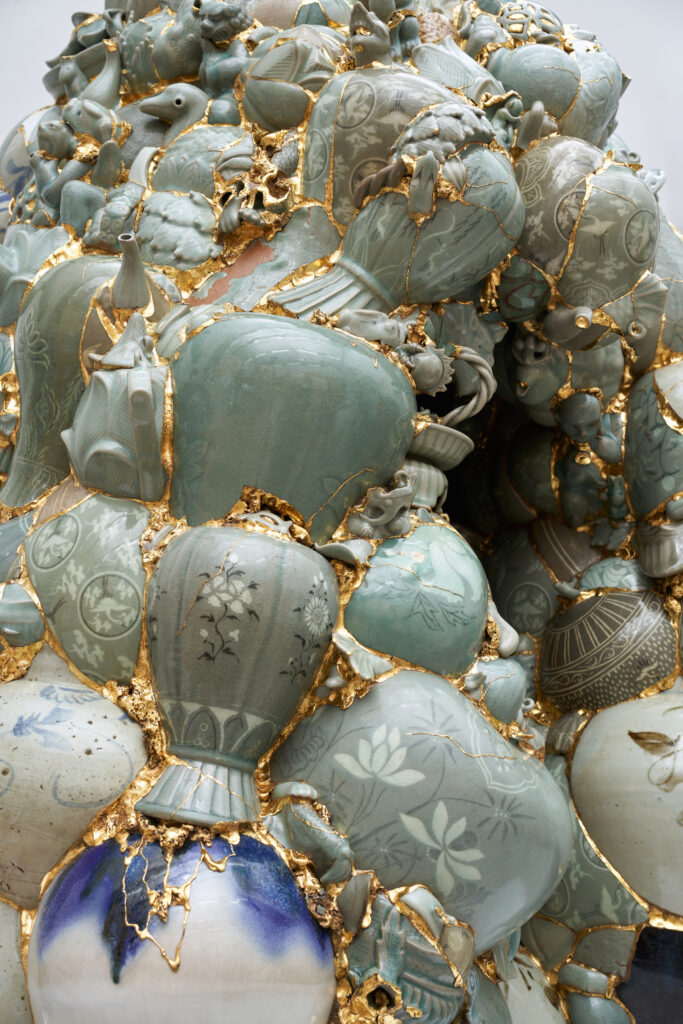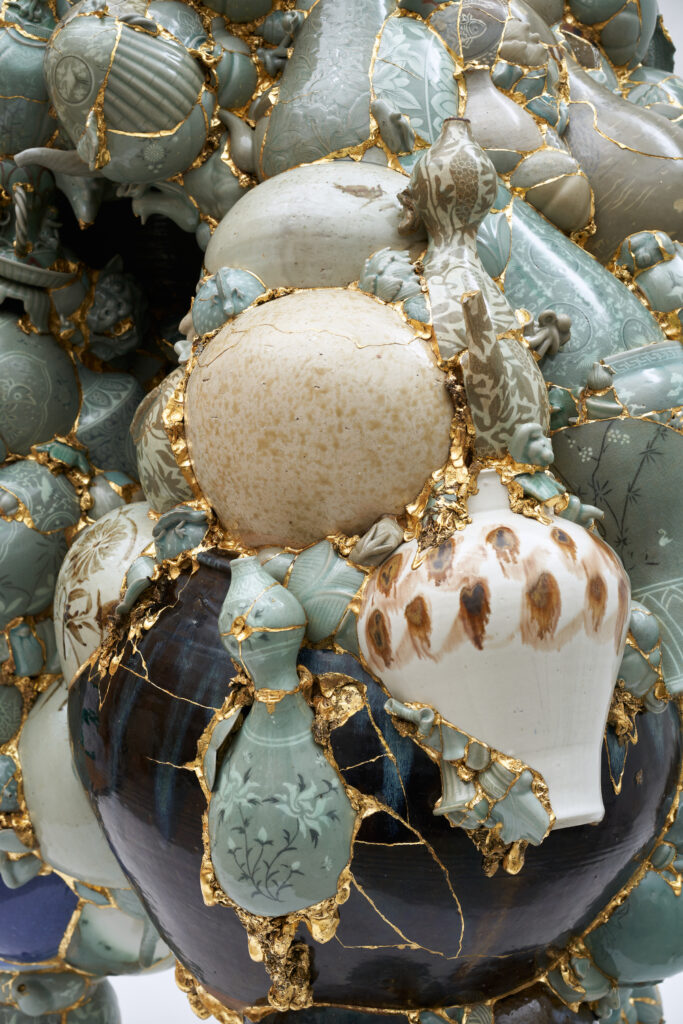For over two decades, Korean artist Yeesookyung has captivated the international art world with her Translated Vase series, shimmering sculptural forms pieced together from fragments of broken porcelain. Drawing inspiration from the refined ceramics of Korea’s Joseon Dynasty, Yeesookyung transforms discarded shards into luminous new bodies, their seams gilded with 24-carat gold. The result is both fragile and resilient, a meditation on beauty, imperfection, and renewal. In this conversation with Culturalee, she reflects on the poetic power of porcelain, the legacy of Korean craft, and the philosophy that continues to guide her practice.

How did you first encounter the kintsugi process, and what drew you to reinterpret it as a central element in your art?
I would first like to clarify that my work does not use the Kintsugi technique. Many years ago, I had some broken ceramic shards in hand, and I began experimenting by joining the fragments in different angles and then sealing them together with gold. It was only after these attempts that I came to learn about the existence of Kintsugi. While Kintsugi intends to repair and restore, I do not intend to do so. In my work, gold – one of the key materials – does not serve the purpose of restoration or mending. Rather, it highlights the very event of breakage, and perhaps even allows us to discover a radiant beauty that can emerge from the ruins themselves. Below is the story of how the Translated Vase series came into being.
My Translated Vase series was first conceived in 2001. While participating in the Albisola Ceramic Biennale in Italy that year, I encountered the poem “Baekjabu”, written by Kim Sangok in 1947. The poem celebrates the beauty of white porcelain from the Joseon dynasty of Korea. A curator translated it from English to Italian and shared it with a local ceramicist. My project was to have this ceramicist create 12 vases in the style of 18th-century Joseon porcelain, inspired only and purely by her imagination drawn from reading the poem. The resulting works became hybrid creations merging time and tradition.
Upon returning to Korea after the exhibition, I had the opportunity to visit a ceramic studio. There, I witnessed an unforgettable scene: a master ceramicist, dressed in a traditional white Korean outfit, slowly walking toward his wood-fired kiln, carefully inspecting each piece. Suddenly, he began smashing many of his works. I was frozen, unable to understand what was happening. Later, I learned that these ceramic masters, in an effort to maintain the rarity and value of true masterpieces, would destroy their own work. More so, in a country whose history has been marked by destruction, it was rare for these delicate pieces to survive.
My role is to collect these discarded ceramic fragments, intervening to create new narratives. The shards come together, infinitely proliferating into new forms. I fill the cracks with 24K gold leaf—a choice inspired by the fact that in Korean, the words “crack” and “gold” share the same sound: Geum.

In your Translated Vase series, broken fragments are reassembled into new forms—how do you see this process reflecting themes of life, death, and renewal?
While working, I often encounter moments where the shards I pick up randomly fit together perfectly, as if by magic. And surprisingly, this happens again and again. These moments offer me a glimpse of enlightenment, revealing that we are all connected in the universe, just like these fragments. It goes beyond simply celebrating and embracing the imperfect and the vulnerable aspects of the vase—it shows me that everything has its place. The golden seams that bind these pieces together feel like calligraphic brushstrokes. The act of connecting the shards and reshaping them beyond their original forms in the Translated Vase occurs to me as a metaphor for how misinterpretation can open new paths of understanding.
Could you give a bit of insight into the Kintsugi process – is it studio-based, how long is the process, and do you create a complete ceramic artwork and destroy it before putting it back together, or start with fragments and piece them together to make a whole?
I do not deliberately destroy completed ceramics. Instead, I collect broken fragments. Three or four times a year, I travel across Korea to gather these precious pieces from ceramic masters. More recently, fragments from beyond Korea have also become part of the work. Some shards, surprisingly, appear to come from North Korea. Others include old ceramic pieces from Japan and even reproductions of royal ceramics from Naples, Italy. I put the fragments together like a puzzle to form a shape, fill the gaps with epoxy, and then cover the seams with pure gold leaf to finish the piece. Lately, I’ve been really focusing on the lines that fill the spaces between the fragments, trying to give them expression and energy, almost like brushstrokes in calligraphy. I find myself thinking of the Translated Vase more like a painting than a sculpture. I especially pay attention to how the golden lines move across the ceramic shards, each with slightly different colors and textures, almost as if they were painted with a brush..

Your practice spans sculpture, performance, video, painting, and drawing. How do you decide which medium best conveys a particular narrative or idea?
There’s a medium that fits whatever I want to express, and fortunately, I have no fear of learning and experimenting with new media. I’m still searching for it, and I’m grateful that in the early days, when I was not very well known as an artist, I had the freedom to experiment with various media. At that time, many people told me that my work was too scattered and lacked a clear identity, and that I wouldn’t succeed as an artist if I continued in that way.
Now, handling multiple media has become a part of my identity. If you look closely, although my work is diverse, it seems interconnected, like organs in a body. Regardless of my intentions, it grows and multiplies like living beings connected in a forest.
Among my works, the Translated Vase series is perhaps the most well-known, but I have continued to explore many different media. Fortunately, in my work, labor and reflection seem to complement each other perfectly. I don’t set rigid goals or push myself toward an outcome; rather, as I work with my hands and body, creative ideas naturally arise. The joy of moving in sync—physically and mentally—seems to be a defining feature of my practice.
Much of your work explores contrasts such as past and present, reality and unreality, or the sacred and the secular. How do these dualities shape your creative process?
There are many things in this world that remain beyond our understanding, and what we once believed to be true can later prove to be false. Our tendency to define and categorize too quickly is simply a human way of simplifying reality. History shows us that in the pursuit of uniformity, countless beings have been lost or destroyed. Despite all the technological advances, the world remains full of contradictions and uncertainties. This perspective naturally finds its way into my work.
Ancient myths and cultural stories often inspire your art. What role do these narratives play in bridging personal experience with universal human themes?
I don’t think it is anything new that mythical beings have long inspired artistic creation. As an artist, and simply as a human being, I live with a sense of anxiety. Our lives inevitably confront us with unpredictable dangers, and I believe that myth offers a source of strength to overcome and transcend this anxiety. To borrow from the past is to engage with a universal language, while at the same time opening infinite possibilities to reinterpret it in my own voice. Today, narrative elements have become increasingly important in the making of art. The richer the narrative, the deeper the resonance of a work, and the broader the space for dialogue with its audience.
How do your works address the tension between individual identity and collective society or systems?
When I look inward, I find within myself the experiences of an immigrant, an outsider, and a minority. The deeper I go into my work, the less I see myself as a single, isolated being, and the more I come to understand that we are all interconnected. Through this perspective, I reflect on the relationship between self and other, individual and community, and the world and society.
You often integrate cultural references from different countries. What challenges and possibilities arise when translating stories and symbols across cultures?
When I encounter creations born out of the merging of different cultures, I am drawn to the sense of interconnectedness that binds everything together, as well as the invisible energy that fills the universe. This process is not new; it can be traced back to ancient times and even found in the fabric of everyday life rather than in art alone. To me, these instances suggest traces of belief that transcend language and environment, blending and dissolving into one another across time.
Looking at your artistic journey, how has your vision of art’s role in exploring human existence evolved over time?
I’m not sure. I tend to be focused solely on my work and follow a simple routine, so I’m relatively insensitive to change, and I don’t seek to define the role of art. I simply hope that by finishing each day well, I can become a slightly different version of myself than yesterday, discovering a better version along the way. I think I value “continuity” more than “change,” and I want to continue working as I do now.
What project are you most proud of, and what are you working on next?
I feel proud and affectionate toward all of my works. Regardless of how much attention they receive or how widely they are recognized, each piece embodies the concerns and explorations I had at the time of its creation. I will be participating in a group exhibition at the Gwangju Museum of Art this August and the Taipei Biennale in November. I am continuing to explore Southeast Asian women’s folklore and mythology, but these projects will require more time for development and presentation. I am also experimenting with works that incorporate the latest AI technologies.
For more information visit https://www.yeesookyung.com



